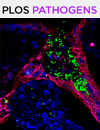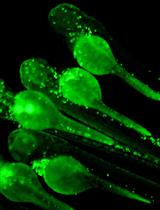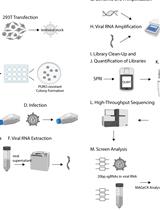- EN - English
- CN - 中文
Generating Three-dimensional Human Granulomas in vitro to Study Mycobacterium tuberculosis-host Interaction
通过体外生成三维人体肉芽肿研究结核分枝杆菌与宿主的相互作用
发布: 2020年11月20日第10卷第22期 DOI: 10.21769/BioProtoc.3820 浏览次数: 4699
评审: Alexandros AlexandratosHsih-Yin Tan
Abstract
Granulomas are organized multicellular structures that constitute the hallmark of an infection by the human pathogen Mycobacterium tuberculosis (Mtb). A better understanding of the complex host-Mtb interactions within the granuloma’s environment may lead to new therapeutic or preventive tools to improve the control of the tuberculosis pandemic. To date, several in vitro models that are able to mimic human nascent granulomas have been reported. Here we describe a protocol in which Mtb-infected human peripheral blood mononuclear cells (PBMCs) are embedded within a collagen matrix leading to the formation of three-dimensional micro-granulomas. Subsequently, PBMCs and Mtb can be retrieved allowing multiparametric readouts from both the host and the pathogen. In addition to the incorporation of a physiological extracellular matrix, this model has the singular advantage of recapitulating dormant-like Mtb features, as well as reproducing Mtb resuscitation observed under immunomodulatory treatments, which have not been reported in other published protocols to generate in vitro granulomas.
Keywords: Mycobacterium (分枝杆菌)Background
Tuberculosis (TB) is an air-borne disease that encompasses pulmonary and extra-pulmonary infections by the human pathogen Mycobacterium tuberculosis (Mtb). Causing an estimated 1.5 million deaths in 2019 (WHO, 2019), TB remains the world’s deadliest infectious disease. The hallmark of the immunopathogenesis of TB is the formation of structurally organized, multicellular clusters called granulomas (Gengenbacher and Kaufmann, 2012). These structures mainly consist of a core of infected and non-infected macrophages surrounded by a rim of lymphocytes. The hostile environment within granulomas pushes Mtb to enter a slow- or non-replicating dormant state likely associated with a latent form of the disease. Consequently, Mtb dormancy leads to increased tolerance to antibiotics targeting metabolic pathways active during mycobacterial replication.
New strategies are urgently needed in order to lessen the TB death toll. Such strategies may arise from a better understanding of the infection within the granuloma’s environment. However, the complex pathophysiology of Mtb infection makes the development of relevant preclinical models particularly challenging. Despite the widespread use of animal models in the TB field, the establishment of latency and granulomatous lesions comparable to the ones seen in humans can only be observed in non-human primates. Yet, drawbacks inherent to this animal model, such as its high cost or ethical concerns, have favored the development of in vitro models (Guirado and Schlesinger, 2013). In that context, several independent groups have reported in vitro models based on the infection of human peripheral blood mononuclear cells (PBMCs) with virulent Mtb (Kapoor et al., 2013; Guirado et al., 2015; Agrawal et al., 2016; Arbués et al., 2020; Tezera et al., 2017). Despite lacking some relevant cell types (e.g., neutrophils) and the full tissue conditions (such as lung structure or vascularization), such models are able to mimic the organization of human nascent granulomas, orchestrated by relevant cytokines.
The protocol described here notably incorporates two major advantageous features. On the one hand, Mtb-infected PBMCs are embedded in a three-dimensional (3D) matrix of collagen and fibronectin, main components of the lung extracellular matrix (Stek et al., 2018). On the other hand, Mtb displays features associated with dormancy such as accumulation of intracellular triacylglycerides into lipid inclusions, loss of acid-fastness, transcriptional changes leading to a shift in carbon and energy metabolisms, and increase in antibiotic tolerance (Kapoor et al., 2013). Remarkably, this model was also able to reproduce the differential rate of latent TB reactivation observed in the clinic upon treatment with different TNF-α-neutralizing biologics (Arbués et al., 2020). Some particular limitations of this model to take into account are the difficulty of adding new immune cells for dynamic studies or its relatively low throughput.
In conclusion, the in vitro granuloma model described hereunder is particularly relevant for studies focusing on mycobacterial dormancy as well as further understanding the mechanisms involved in Mtb resuscitation.
Materials and Reagents
Filtered micropipette tips (various volumes) (e.g., Clearline, catalog numbers: 713115 , 713117 and 713118 )
Serological pipettes (various volumes) (e.g., Falcon, catalog numbers: 357543 and 357551 )
1.5/2.0 ml microtubes (e.g., Sarstedt, catalog numbers: 72.692.005 and 72.693.005 )
15/50 ml conical centrifuge tubes (e.g., Falcon, catalog numbers: 352096 and 352070 )
Syringe (e.g., BD, catalog number: 300865 )
0.20 μm syringe filter (e.g., Sarstedt, catalog number: 83.1826.001 )
Stericup filter unit, Millipore Express PLUS high flow rate membrane (Millipore, catalog number: S2GPU01RE )
Tissue culture plates, 24-well, flat bottom (e.g., Falcon, catalog number: 353047 )
Single-cell suspension of Mycobacterium tuberculosis (Mtb) prepared according to published methods (bacterial concentration determined by colony forming unit quantification)
Note: Mtb H37Rv (Sébastien Gagneux’s strain collection) was used in our published study (Arbués et al., 2020). Different strains or mycobacterial species could also be used.
Human peripheral blood mononuclear cells (PBMCs) isolated from whole blood or buffy coats following a standard protocol ( Vogel et al., 2018 ) (samples stored in liquid nitrogen can be used, when viability ≥ 95% assessed by trypan blue exclusion)
RPMI-1640 medium, with L-glutamine and sodium bicarbonate (e.g., Sigma-Aldrich, catalog number: R8758 )
Fetal bovine serum (FBS) (e.g., Gibco, catalog number: 10270 ), heat inactivated
Benzonase, E. coli recombinant (BioVision, catalog number: 7680 )
Human serum off-the-clot, type AB (PAN Biotech, catalog number: P40-2701 ), heat inactivated and filtered (Stericup)
Trypan blue solution (e.g., Sigma-Aldrich, catalog number: T8154 )
PureCol bovine type I collagen solution, 3 mg/ml (Advanced BioMatrix, catalog number: 5005 )
Fibronectin from human plasma, 0.1% solution (Sigma-Aldrich, catalog number: F0895 )
Dulbecco’s Phosphate Buffered Saline (PBS) 10x (Sigma-Aldrich, catalog number: D1408 )
Sodium hydroxide solution (NaOH) 1 N for cell culture (Sigma-Aldrich, catalog number: S2770 )
Collagenase type IV, sterile filtered (Sigma-Aldrich, catalog number: C1889 )
Calcium chloride dihydrate (CaCl2·2H2O) (PanReac AppliChem, catalog number: A4689 )
Triton X-100 (e.g., Sigma-Aldrich, catalog number: T8787 )
Millipore double distilled water, sterile
Thawing medium (see Recipes)
Resting medium (see Recipes)
Complete medium (see Recipes)
Extracellular Matrix (ECM) solution (see Recipes)
Collagenase solutions (see Recipes)
0.1% Triton X-100 (see Recipes)
Equipment
Class II biosafety cabinet
5% CO2 incubator, set at 37 °C
Cell counting chamber
Inverted bright-field/phase-contrast microscope (e.g., Leica DM IL LED)
Note: We routinely use a 20x objective to count the PBMCs and a 10x objective to monitor granuloma formation (Procedure A, Steps 1f and 2i, respectively)
Centrifuge for 15/50 ml conical tubes, maximum RCF ≥ 3,000 x g (e.g., Beckman Coulter Allegra X-15R)
Microcentrifuge for 1.5/2.0 ml microtubes, maximum RCF ≥ 6,000 x g (e.g., Eppendorf 5424R)
Procedure
文章信息
版权信息
© 2020 The Authors; exclusive licensee Bio-protocol LLC.
如何引用
Arbués, A., Kammüller, M. and Portevin, D. (2020). Generating Three-dimensional Human Granulomas in vitro to Study Mycobacterium tuberculosis-host Interaction. Bio-protocol 10(22): e3820. DOI: 10.21769/BioProtoc.3820.
分类
免疫学 > 宿主防御 > 人
微生物学 > 微生物-宿主相互作用 > 体外实验模型
细胞生物学 > 基于细胞的分析方法 > 细菌感染
您对这篇实验方法有问题吗?
在此处发布您的问题,我们将邀请本文作者来回答。同时,我们会将您的问题发布到Bio-protocol Exchange,以便寻求社区成员的帮助。
Share
Bluesky
X
Copy link














